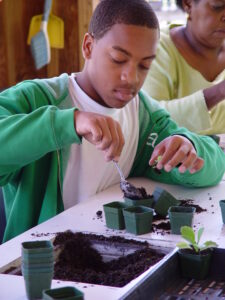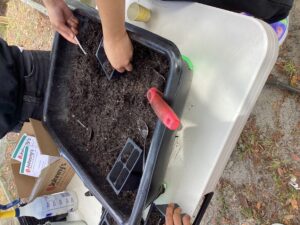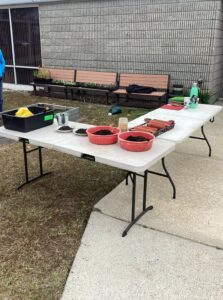School Gardens
go.ncsu.edu/readext?978778
en Español / em Português
El inglés es el idioma de control de esta página. En la medida en que haya algún conflicto entre la traducción al inglés y la traducción, el inglés prevalece.
Al hacer clic en el enlace de traducción se activa un servicio de traducción gratuito para convertir la página al español. Al igual que con cualquier traducción por Internet, la conversión no es sensible al contexto y puede que no traduzca el texto en su significado original. NC State Extension no garantiza la exactitud del texto traducido. Por favor, tenga en cuenta que algunas aplicaciones y/o servicios pueden no funcionar como se espera cuando se traducen.
Português
Inglês é o idioma de controle desta página. Na medida que haja algum conflito entre o texto original em Inglês e a tradução, o Inglês prevalece.
Ao clicar no link de tradução, um serviço gratuito de tradução será ativado para converter a página para o Português. Como em qualquer tradução pela internet, a conversão não é sensivel ao contexto e pode não ocorrer a tradução para o significado orginal. O serviço de Extensão da Carolina do Norte (NC State Extension) não garante a exatidão do texto traduzido. Por favor, observe que algumas funções ou serviços podem não funcionar como esperado após a tradução.
English
English is the controlling language of this page. To the extent there is any conflict between the English text and the translation, English controls.
Clicking on the translation link activates a free translation service to convert the page to Spanish. As with any Internet translation, the conversion is not context-sensitive and may not translate the text to its original meaning. NC State Extension does not guarantee the accuracy of the translated text. Please note that some applications and/or services may not function as expected when translated.
Collapse ▲Access within Schools Garden
In my vision of an ideal world, school gardens that accommodate all would incorporate the principle of Universal Design and be an integral part of the original building plan for all schools. But in reality, addressing the issue of access within school gardens can be a daunting task. Schools often have limited resources and gardens are later additions to the school grounds. Here are some ideas on making school gardening available to all students:
Tabletop Gardening:
Engage students in gardening through tabletop activities such as planting seeds, separating or potting up seedlings, and working with houseplants. This allows for everyone to participate and provides productivity in a school gardening program, particularly for students with special needs.

Gardening with the Ability Garden, houseplants.

Seeding in cell pack on a table.

Tabletop potting station setup by sidewalk for accessibility.
East to Reach Raised Beds:
While providing ADA-compliant paths to raised beds might not always be feasible, schools can construct raised beds along existing sidewalks for students with mobility challenges. Wheelchair-accessible raised bed designs are available, and growing in bags, like soil or fabric grow bags, offers a portable and reusable alternative.
Growing Vertically:
Explore online resources for purchasing or building vertical gardens that can be placed in certain areas on school grounds. Options include trellises, living walls, espalier, stakes, cages, wall-mounted pots, hanging pots, cane teepees, archways, and growing on fences, among others.
Gardening Tools:
Utilize adaptive tools to make gardening easier for students facing accessibility challenges. Regularly search for terms like “gardening tools for wheelchair users” or “adaptive garden hand tools” to discover a variety of options tailored to specific needs.
Gardening for the Senses:
Consider the sensory aspects of gardening beyond visual impact. Use plants with a variety of textures, fragrant and edible leaves, and those that produce sounds, such as the seed pods of Baptisia australis (False Indigo). Explore sensory plant using Sensory tags In NC State Extension Gardener Plant Toolbox.
Expression by All:
School gardens can serve as spaces where children of all abilities express themselves. Embrace multiple engagement approaches, allowing students to communicate and express themselves through various means, including touching, smelling, tasting, drawing, and pointing at pictures.
While creating school gardens for all to use may present challenges, these ideas demonstrate that with creative solutions and a commitment to include everyone, it’s possible to make gardening a rewarding experience for all students, regardless of their abilities or needs.
Resources:
NC State Center for Universal Design
Farmers Almanac – How to Grow Vertically in Your Garden
Virginia Cooperative Extension – Vertical Gardening Using Trellises, Stakes, and Cages
DiynCrafts – 20 DIY Vertical Gardens You Can Set Up Anywhere
References:
Harte, Helene Arboute. (2013). Universal Design and Outdoor Learning. Dimensions of Early Childhood. Vol 41, No 3, 18 – 22.
Spring in the School Garden
In New Hanover County, as the warm weather becomes more consistent, we are working with students at their schools to direct seed carrots, early peas, nasturtiums, radishes, lettuce, spinach and cilantro. The week of March 17th, planting sunflower seeds in soil blocks to bring back to the greenhouse for an Earth Day planting in the ground back at the school. Also started in the greenhouse, borage, parsley, calendula and more cilantro, which will go in the ground between mid-March & mid-April.
Fun facts we share about some to the plants:
- cilantro seeds are know in the kitchen as coriander
- cilantro tastes link soap to some people, due to differences in our olfactory-receptor genes
- borage leaves have a cucumber flavor
- borage flower are edible
- parsley is food for black swallowtail butterflies




